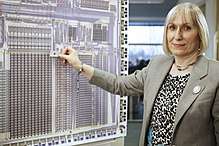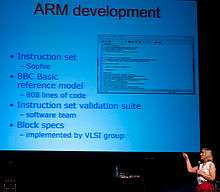Sophie Wilson
Sophie Mary Wilson CBE FRS FREng[4] (born 1957) is an English computer scientist, who helped design the BBC Micro and ARM architecture.
 | |
| Born | Roger Wilson 1957 (age 62–63)[1] |
| Nationality | British[3] |
| Alma mater | Selwyn College, Cambridge University of Cambridge |
| Known for | |
| Awards |
|
| Scientific career | |
| Institutions | |
| Website | |
Wilson first designed a microcomputer during a break from studies at Selwyn College, Cambridge. She subsequently joined Acorn Computers and was instrumental in designing the BBC Micro, including the BBC BASIC programming language whose development she led for the next 15 years. She first began designing the ARM reduced instruction set computer (RISC) in 1983, which entered production two years later. It became popular in embedded systems and is now the most widely used processor architecture in smartphones. Wilson is currently a director at the technology conglomerate Broadcom Inc.[5][6] In 2011, she was listed in Maximum PC as number 8 in an article titled "The 15 Most Important Women in Tech History".[7] She was made a Commander of the British Empire in 2019.
Early life and education
Wilson was raised in Leeds, Yorkshire, by parents who were both teachers, her father specialising in English and her mother in physics.[2] From 1975,[8] she studied computer science and the Mathematical Tripos at Selwyn College, University of Cambridge.[3] In an Easter break from university, Wilson designed a microcomputer with a MOS Technology 6502 microprocessor inspired by the earlier MK14,[9] which was used to electronically control feed for cows.[6]
Career
In 1978, she joined Acorn Computers Ltd, after designing a device to prevent cigarette lighter sparks triggering payouts on fruit machines.[6] Her computer design was used by Chris Curry and Hermann Hauser to build the Acorn Micro-Computer, the first of a long line of computers sold by the company.[10][9]
In July 1981, Wilson extended the Acorn Atom's BASIC programming language dialect into an improved version for the Acorn Proton, a microcomputer that enabled Acorn to win the contract with the British Broadcasting Corporation (BBC) for their ambitious computer education project.[11] Hauser employed a deception, telling both Wilson and colleague Steve Furber that the other had agreed a prototype could be built within a week. Taking up the challenge, she designed the system including the circuit board and components from Monday to Wednesday, which required fast new DRAM integrated circuits to be sourced directly from Hitachi. By Thursday evening, a prototype had been built, but the software had bugs, requiring her to stay up all night and into Friday debugging. Wilson recalled watching the wedding of Prince Charles and Lady Diana Spencer on a small portable television while attempting to debug and re-solder the prototype. It was a success with the BBC, who awarded Acorn the contract. Along with Furber, Wilson was present backstage at the machine's first airing on television, in case any software fixes were required. She later described the event as "a unique moment in time when the public wanted to know how this stuff works and could be shown and taught how to program."[12]
The Proton became the BBC Micro and its BASIC evolved into BBC BASIC, whose development was led by Wilson for the next 15 years. As well as programming, she wrote the manuals and technical specifications, realising communication was an important part of being successful.[6]
In October 1983, Wilson began designing the instruction set for one of the first reduced instruction set computer (RISC) processors, the Acorn RISC Machine (ARM),[13] The ARM1 was delivered on 26 April 1985 and worked first time.[14] This processor type was later to become one of the most successful IP cores – a licensed CPU core – and by 2012 was being used in 95% of smartphones.[6]
Wilson designed Acorn Replay, the video architecture for Acorn machines. This included operating system extensions for video access, as well as the codecs, optimized to run high frame rate video on ARM CPUs from the ARM 2 onwards.
She was a member of the board of the technology and games company Eidos Interactive, which bought and created Eidos Interactive, for the years following its flotation in 1990. She was a consultant to ARM Ltd when it was split off from Acorn in 1990.

Since the demise of Acorn Computers, Wilson has made a small number of public appearances to talk about work done there.[15]
She is now the Director of IC Design in Broadcom's Cambridge, UK office.[5] She was the Chief Architect of Broadcom's Firepath processor.[16] Firepath has its history in Acorn Computers, which, after being renamed to Element 14, was bought by Broadcom in 2000.
Wilson was listed in 2011 in Maximum PC as number 8 in an article titled "The 15 Most Important Women in Tech History".[7]
Honours and awards
She was awarded the Fellow Award by the Computer History Museum in California in 2012 "for her work, with Steve Furber, on the BBC Micro computer and the ARM processor architecture."[1][17] In 2013 Wilson was elected as a Fellow of the prestigious Royal Society.[18] She received the 2014 Lovie Lifetime Achievement Award in acknowledgement for her invention of the ARM processor.[19] In 2016 she became an honorary fellow of her alma mater, Selwyn College, Cambridge.[8]
Wilson was appointed Commander of the Order of the British Empire (CBE) in the 2019 Birthday Honours for services to computing.[20]
Personal life
Wilson underwent gender reassignment from male to female in 1994.[21][22] She enjoys photography and is involved in a local theatre group, where she is in charge of costumes and set pieces and has acted in a number of productions. She has also played a cameo role as a pub landlady in the BBC television drama Micro Men, in which a younger Wilson is played by Stefan Butler.[22]
See also
References
- "Sophie Wilson: 2012 Fellow". Computer History Museum. Retrieved 15 May 2020.
- "Oral History of Sophie Wilson 2012 Computer History Museum Fellow" (PDF). Archive.computerhistory.org. Retrieved 10 April 2018.
- "Sophie Wilson@Everything2.com". Archived from the original on 4 December 2009. Retrieved 1 January 2010.
- "List of Fellows".
- Murry, Sarah. "Broadcom Engineer Sophie Wilson Named Computer History Museum 2012 Fellow". Broadcom. Retrieved 22 May 2012.
- Bidmead, Chris (2 May 2012). "Unsung Heroes of Tech: ARM creators Sophie Wilson and Steve Furber". The Register. Retrieved 9 November 2015.
- Bouman, Amber (1 March 2011). "The 15 Most Important Women in Tech History". Maximum PC. Retrieved 12 March 2012.
- "Recognition for Computer Pioneer". Selwyn College. 21 April 2016. Retrieved 15 May 2020.
- Gelenbe 2009, p. 118.
- Russell, R. T. "A History of BBC BASIC". Retrieved 10 June 2007.
- Gelenbe 2009, p. 119.
- "BBC Micro ignites memories of revolution". BBC News. 21 March 2008. Retrieved 26 October 2015.
- Gelenbe 2009, p. 121.
- Hohl & Hinds 2014, pp. 5-6.
- "CU Computer Preservation Society 1998–1999". Cambridge University Computer Preservation Society. 29 August 2002. Retrieved 28 June 2011.
On 20th October 1998, Sophie Wilson spoke to an audience of 22 about Acorn from the BBC to the ARM.
- Smotherman, Mark. "Which Machines Do Computer Architects Admire?". Retrieved 22 May 2012.
- Williams, Alun (20 January 2012). "Four ARM cores for every person on earth – Furber, Wilson honoured". Electronics Weekly. Retrieved 7 March 2012.
- "Ms Sophie Wilson FREng FRS". Royal Society. Archived from the original on 22 February 2014.
- "Sophie Wilson's ARM Microprocessor" (in Italian). 5 May 2015. Retrieved 12 March 2019.
- "No. 62666". The London Gazette (Supplement). 8 June 2019. p. B10.
- "You are beautiful and don't you forget it. A word about acceptance". Beyond Positive. 9 May 2012.
- Williams, Chris (8 October 2009). "BBC4's Micro Men: an interview and review". Drobe. Archived from the original on 16 March 2012. Retrieved 20 June 2010.
Sources
- Hohl, William; Hinds, Christopher (2014). ARM Assembly Language: Fundamentals and Techniques, Second Edition. CRC Press. ISBN 978-1-482-22985-1.CS1 maint: ref=harv (link)
- Gelenbe, Erol (2009). Fundamental Concepts in Computer Science. Imperial College Press. ISBN 978-1-848-16291-4.CS1 maint: ref=harv (link)